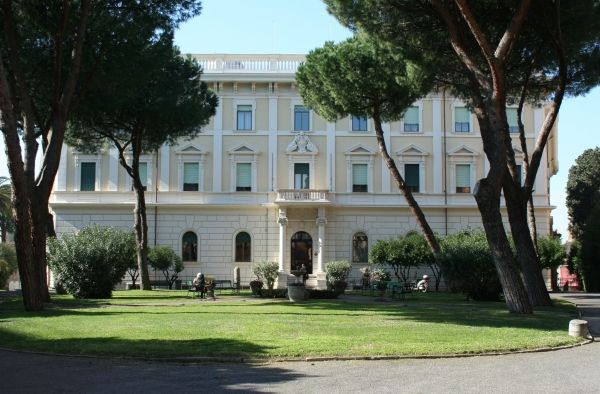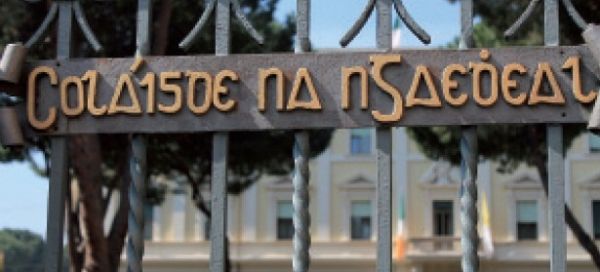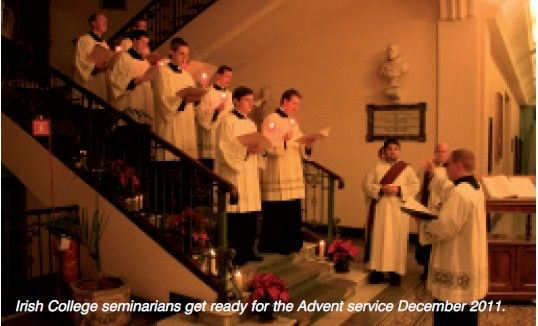A critical report about the Irish College leaves Ireland’s famous seminary in Rome facing difficult times ahead.
It was during the preparation for the millennium celebrations of 2000 that the Pontifical Irish College got into its stride as a warm, outward-looking point of reference in Rome for people celebrating two millennia of Christianity. Until then it had seemed rather austere, set back behind formidable gates on the road that runs down one side of S. Giovanni hospital. It was a highly regarded place for Irish seminarians, young men training for the priesthood, whose main purpose was to get through their formation and rigorous academic training at Rome’s pontifical universities. But there wasn’t a great deal of time in its brief for people who lived outside the gates. With the arrival of John Fleming (now Bishop of Killala, County Mayo) as rector in 1994, things began to change. In the two years before the opening of the new millennium his was the guiding hand behind a happy and hard-working committee that prepared the way for pilgrims to the Eternal City. Its work included the renovation of the Irish chapel in St Peter’s basilica, a pilgrim centre at the Irish College itself, and a useful guidebook that covered some of the common – and less common – aspects of the city. Everyone, Irish or not, was given a welcome.
From then on the activities of the Irish College went from strength to strength. Under the guidance of the next rector, Liam Bergin, and his vice rector, Albert McDonnell, the college became a meeting place for religious and lay people, for academics and students, politicians and diplomats, for all nationalities and major religions. A series of historical lectures engaged some of the best academic minds on subjects relating to Ireland, the Catholic Church in Ireland, the country’s historical and diplomatic relations with the Holy See. Interfaith conferences, attended also by top Jewish and Muslim theologians, were no less illuminating. There were concerts, plays and art exhibitions. An archivist was taken on and the art collection restored. A remodernisation project improved the buildings and their surrounding grounds and also saw the renovation of the previously rather oldfashioned chapel and the conversion of a former convent building into a guesthouse, Villa Irlanda, for visitors to Rome. There were special liturgies to coincide with the important seasons of the Church calendar, weddings and the sacraments of First Communion and Confirmation for children of Irish/English-speaking/Italian parents. And all the time the formation of future and newly-ordained priests continued.
Vocations from Ireland might have fallen off but priests from other continents, as well as some from Italy, were given accommodation during their studies in Rome. One of the most tragic was Ragheed Aziz Ganni, a Chaldean Catholic priest from Iraq who was murdered in 2007 in his home-town of Mosul after celebrating Mass in his parish. Ganni, whose mosaic now adorns the renovated chapel, lived at the Irish College from 1996-2003 while studying at the Angelicum University before going back to his war-torn country.
Famous politicians were invited to stay and to lecture. Mary McAleese, the Irish president, was a frequent visitor, but more surprising was the stay of British prime minister Tony Blair when he visited Pope John Paul II in February 2003, a meeting that included talks on Iraq just weeks before the March invasion.
During the first decade of the 21st century fundraising increased, helped in part by the economic boom in Ireland, and the drop in student numbers was arrested. There are currently 60 students living at the College, half of whom are from Ireland.
Now, after several decades of extremely prolific outward-looking activity, three of the top figures at the College, the vice rector Albert McDonnell, the director of formation Billy Swan and the spiritual director Chris Hayden, have been recalled to Ireland. In lay terms this is the equivalent of three key members of a management team being moved to other jobs, leaving only a relatively new and inexperienced chief executive office (the rector) to carry on.
The formal news of the almost immediate departures was given in May by the new rector of the College, Ciarán O’Carroll, who only arrived in Rome from a Dublin parish last autumn with no previous experience of this kind of job. The announcement sent shockwaves through the friends of the College, both in Ireland and Rome. It left those who had benefited from its record of academic, cultural, spiritual and ecumenical leadership wondering what had happened – and what would happen next.
A few weeks later an article appeared in the Irish Times stating that the findings of a report by the Archbishop of New York, Cardinal Timothy Dolan, were highly critical of the College. Commissioned by the Vatican as part of its investigation into the Irish Church in the wake of the child abuse scandals, the leaks in the Irish Times said that the Dolan report had found fault with students, staff and trustees (Ireland’s four archbishops). Students were accused of being sloppily dressed, staff for not supervising students enough, and the trustees for being disengaged from College governance. The report also included allegations that the College had a reputation for being “gay-friendly”, although it also acknowledged that there was no evidence of a homosexual subculture or immorality among students . These were all allegations that those who had frequented the College over the years found difficult to comprehend.
In return, the four Irish trustees of the College have blasted the Dolan report as being coloured by “deep prejudice”, as hostile in tone and content and marred by errors of fact. The bishops’ statement has also criticised those responsible for the report – all of whom are American and one of whom is the rector of the North American College, another seminary in Rome – as having been swayed by their own views of “orthodoxy, priestly identity, separation and devotion”.
This is hard-hitting stuff from both sides of the divide in the Roman Catholic Church, with undercurrents about national identity and definitions of orthodoxy that most outsiders find too hard to follow. But the one thing that strikes most of those left behind after the departure of McDonnell, Swan and Hayden is that there are difficult times ahead for the Pontifical Irish College. Is it going to have to face a new more inward-looking period, close the gates of its magnificent grounds and shut the unorthodox out?
Or will it be able to continue its outward-looking leadership that has been an inspiration for so many – whether religious or lay – in Rome and elsewhere over the last few decades?
The new team – a next vice-rector and head of formation have already been appointed, both of whom are said to be conservative in outlook – has a tough job ahead.
by Mary Wilsey
editorial@wantedinrome.com
























